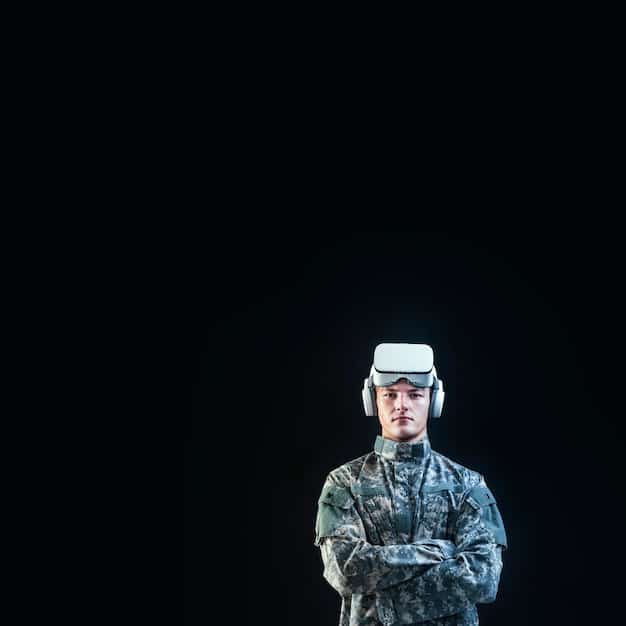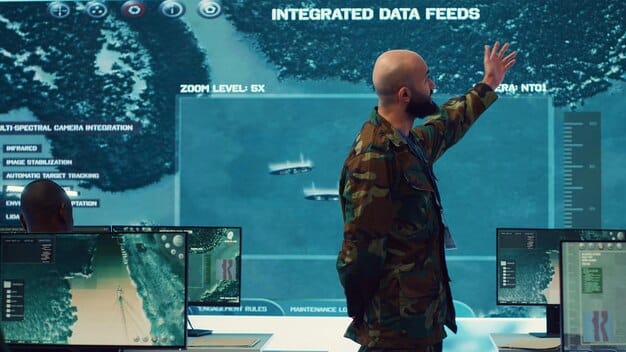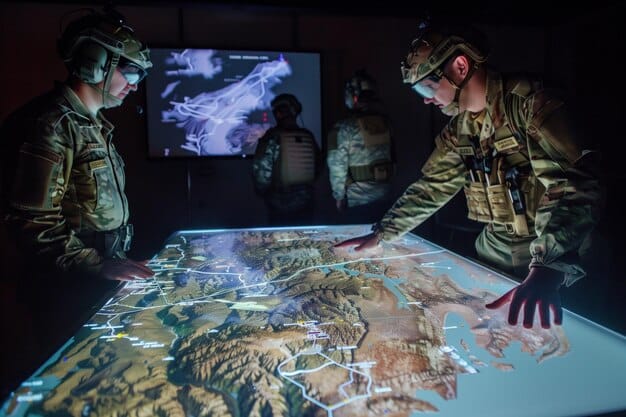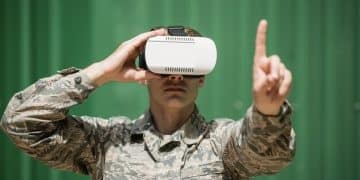How the US Military Integrates AI into Combat Simulations

The US military is increasingly embedding artificial intelligence (AI) into its combat simulations to enhance realism, accelerate training cycles, and optimize strategic decision-making, leveraging advanced algorithms to create dynamic and adaptive virtual environments for soldiers, sailors, airmen, and marines.
The landscape of modern warfare is in constant flux, driven by rapid technological advancements. One of the most transformative shifts occurring within defense strategies revolves around the integration of artificial intelligence. Discover firsthand How the US Military is Integrating Artificial Intelligence into Combat Simulations, reshaping the future of military readiness and operational effectiveness.
The Dawn of AI in Military Training Paradigms
The traditional pillars of military training are undergoing a profound transformation, propelled by the advent of artificial intelligence. For decades, combat simulations have served as indispensable tools for preparing service members for the complexities of the battlefield. These simulations, from intricate wargames to sophisticated flight simulators, provide a safe yet challenging environment to hone skills and test tactical approaches.
However, the limitations of conventional simulations—often reliant on pre-programmed scenarios and predictable adversary behaviors—have become increasingly apparent in an era defined by dynamic threats and information warfare. AI steps into this void, offering an unprecedented capacity to generate more realistic, adaptable, and relevant training experiences.
Evolution from Traditional Simulations
Historically, military simulations ranged from table-top exercises to advanced hardware-in-the-loop systems. They were characterized by their deterministic nature, meaning outcomes were largely based on predefined rules and human input. While valuable, this often led to static training environments that struggled to replicate the fluidity and unpredictability of real combat.
- Pre-programmed Scenarios: Many older simulations relied on fixed scripts, limiting trainees’ exposure to unexpected variables.
- Human Instructor Dependence: Extensive human intervention was often required to adapt scenarios or introduce new challenges.
- Limited Adaptability: The ability to dynamically change enemy behavior or environmental conditions was restricted.
- Predictable Outcomes: Repetitive training could lead to predictable responses from trainees, diminishing the learning curve.
The integration of AI aims to shatter these limitations. By introducing machine learning algorithms, generative adversarial networks (GANs), and reinforcement learning, AI can imbue simulations with a level of autonomy and responsiveness never before possible. This allows for the creation of truly “live” training scenarios where the virtual adversary learns and adapts in real-time, mirroring the cognitive challenges of actual combat.
AI’s role extends beyond simply making enemies smarter. It enables the creation of vast, persistent virtual environments, complete with realistic weather patterns, complex urban landscapes, and fluctuating geopolitical situations. This level of environmental fidelity, combined with intelligent adversaries, provides a training ground where critical thinking, rapid decision-making, and adaptability are genuinely tested and refined.
The goal is not merely to train soldiers but to forge adaptive problem-solvers capable of operating effectively in uncertain, chaotic, and ambiguous environments. AI-driven simulations are designed to push trainees beyond their comfort zones, forcing them to innovate and improvise, skills that are paramount for success in contemporary military operations.
Enhancing Realism: Beyond Static Scenarios
One of the most compelling advantages of integrating AI into combat simulations is the drastic increase in realism. Traditional simulations often struggle to replicate the nuanced, unpredictable nature of real-world engagements. AI, however, can introduce dynamic elements that challenge trainees in ways previously unimaginable.
This enhanced realism stems from AI’s ability to process vast amounts of data and generate complex, emergent behaviors. Instead of pre-scripted enemy movements or predictable civilian reactions, AI-driven entities can exhibit intelligent, adaptive patterns that mimic human adversaries or chaotic environmental factors. This means that no two training sessions are exactly alike, preventing rote memorization and fostering genuine critical thinking.
Adaptive Adversaries and Dynamic Environments
At the core of this enhanced realism are AI-powered adaptive adversaries. These virtual opponents are designed not just to follow a sequence of commands but to learn from trainee actions, adjust their tactics, and even predict future moves. Using machine learning techniques, these AI entities can evolve, becoming more challenging as the trainees improve, mirroring the constant push-and-pull of genuine tactical engagements.
- Reinforcement Learning: AI agents can learn optimal strategies by trial and error, rewarding successful tactics and penalizing failures.
- Behavioral Mimicry: AI systems can analyze real-world combat data or even human player behavior to develop highly realistic combat styles.
- Dynamic Response Generation: AI can dynamically generate new threats or opportunities based on the ongoing simulation, ensuring unpredictability.
Beyond intelligent foes, AI contributes to creating dynamic and responsive environments. Simulations can now incorporate sophisticated AI models for civilian populations, complex weather systems, and infrastructure failures that react realistically to military operations. For instance, an AI-driven civilian population might react with fear, anger, or cooperation based on the actions of the training unit, adding layers of ethical and tactical complexity.
This level of environmental fidelity and adaptive adversary behavior pushes trainees to consider a wider spectrum of variables, from rules of engagement in populated areas to navigating compromised communication networks. It forces them to make rapid decisions under pressure, understand unforeseen consequences, and adjust their strategies on the fly—all without the actual risks of a live-fire exercise. Such realistic scenarios better prepare personnel for the mental and emotional demands of actual combat, building resilience and enhancing operational effectiveness.
Accelerating Training and Skill Development
The demanding pace of modern warfare necessitates accelerated and highly effective training methodologies. AI integration into combat simulations provides a robust pathway to achieve this, offering several key advantages that optimize the learning curve and enhance skill acquisition far more rapidly than traditional methods.
One primary benefit is the ability to rapidly iterate through diverse scenarios. Instead of painstaking manual setup or limited scenario availability, AI can instantly generate variations, allowing trainees to experience a multitude of challenges in a shorter timeframe. This exposure to varied situations builds a broader and deeper understanding of tactical principles and decision-making under pressure.
Personalized Learning Pathways
AI’s capacity for data analysis enables the creation of highly personalized training pathways. By tracking individual trainee performance—their strengths, weaknesses, decision-making biases, and learning styles—AI can adapt the simulation to meet specific needs. This contrasts sharply with a one-size-fits-all approach common in many mass training programs.
- Adaptive Difficulty: AI can dynamically adjust the difficulty of scenarios, increasing challenges when a trainee masters a skill and providing more support when they struggle.
- Targeted Feedback: AI systems can identify specific errors or areas for improvement, providing immediate and detailed feedback tailored to the individual.
- Skill Gap Identification: Machine learning algorithms can pinpoint knowledge gaps across teams or individuals, allowing instructors to focus interventions precisely where they are needed.
This personalized approach means that trainees spend less time on concepts they have already mastered and more time on areas requiring development. It creates an optimized learning environment that maximizes time efficiency and resource utilization. Furthermore, AI can generate endless repetitions of specific complex tasks, such as close air support coordination or complex breach operations, allowing for mastery through focused practice.
Beyond individual skill acquisition, AI accelerates the development of team cohesion and dynamic leadership. By presenting scenarios that require complex coordination and rapid communication, AI-driven simulations allow units to practice synchronized movements, evaluate command decisions, and refine their standard operating procedures in a high-fidelity environment. This iterative process, facilitated by AI’s generative capabilities, leads to faster skill development and a higher level of operational readiness for units deployed in unpredictable environments.

Optimizing Strategic Decision-Making and Analytics
Beyond individual soldier training, AI’s integration into combat simulations plays a pivotal role in optimizing strategic decision-making at higher echelons. Modern warfare is as much about data and information superiority as it is about kinetic force. AI-powered simulations offer an unparalleled sandbox for testing complex strategies, analyzing myriad variables, and predicting potential outcomes before real-world deployment.
The ability to run countless iterations of a specific strategic scenario, with varying parameters and AI-driven adversary responses, allows military planners to gain deeper insights into the robustness and resilience of their operational plans. This iterative testing process identifies vulnerabilities, exposes overlooked opportunities, and refines strategic doctrines, leading to more informed and effective decisions in high-stakes environments.
Data-Driven Insights and Predictive Analysis
The true power of AI in strategic simulations lies in its analytical capabilities. As simulations run, AI systems collect vast amounts of data on everything from unit movements and resource consumption to communication patterns and psychological responses of virtual entities. This data, often too complex for human analysis alone, can be processed by machine learning algorithms to reveal hidden patterns and predictive insights.
- Performance Metrics: AI provides detailed metrics on unit effectiveness, resource expenditure, and mission accomplishment in diverse scenarios.
- Vulnerability Identification: Algorithms can pinpoint weaknesses in tactics, potential choke points, or exploitable gaps in defense.
- Predictive Modeling: AI can simulate the likely impact of different strategic choices, projecting outcomes such as casualty rates, logistical strain, or mission success probability.
- “What If” Scenarios: Planners can rapidly test alternative strategies by simply altering parameters, receiving instant feedback on potential consequences.
This data-driven approach moves strategic planning from educated guesswork towards a more scientific, evidence-based methodology. By simulating the “fog of war” with greater fidelity, including factors like supply chain disruptions, civilian unrest, or unexpected enemy reinforcements, AI helps commanders anticipate complex challenges and develop contingency plans. This proactive risk assessment is invaluable for minimizing unforeseen complications and maximizing operational success.
Furthermore, AI can assist in the development of future doctrine and force structures. By simulating emerging threats or novel weapon systems, military leaders can assess their potential impact and adapt training or procurement strategies accordingly. This forward-looking analytical capacity ensures that the military remains agile and prepared for the challenges of an evolving global security landscape, transforming strategic planning from a reactive process into a proactive and data-informed discipline.
Challenges and Ethical Considerations in AI Integration
While the integration of AI into combat simulations offers immense advantages, it is not without significant challenges and crucial ethical considerations. The very power that makes AI so transformative also introduces complexities that demand careful management and robust oversight. Addressing these issues is paramount to ensuring responsible and effective deployment of this technology.
One prominent challenge lies in the data itself. AI systems are only as good as the data they are trained on. Biases present in training data, whether accidental or inherent, can lead to AI behaviors that are unrealistic, unfair, or even detrimental to training objectives. Ensuring diverse, representative, and unbiased datasets is a continuous and complex undertaking.
Maintaining Human Agency and Oversight
A central ethical dilemma revolves around maintaining human agency and meaningful human control over AI systems, particularly as they become more autonomous. While AI can enhance decision-making, the ultimate responsibility for strategic choices and moral outcomes must remain with human operators. This requires careful design of human-AI interfaces and clear lines of accountability.
- Avoiding Algorithmic Bias: Ensuring AI models do not perpetuate or amplify existing biases from training data.
- Transparency and Explainability: Developing “explainable AI” (XAI) so that decision-making processes are understandable and auditable, not black boxes.
- Human-in-the-Loop Design: Designing systems where humans retain final decision authority and can intervene or override AI recommendations.
- Cybersecurity Vulnerabilities: Protecting AI systems from adversarial attacks, data manipulation, or unauthorized access that could compromise simulation integrity.
Beyond technical challenges, there are profound ethical questions. As simulations become hyper-realistic, what are the psychological impacts on trainees? How can the military ensure that AI-driven training doesn’t inadvertently desensitize personnel or promote unethical behaviors due to the simulated environment? These are not trivial concerns and require ongoing psychological research and careful policy formulation.
Furthermore, the reliance on AI for simulation necessitates robust cybersecurity. A compromised AI system could feed false information, create faulty training scenarios, or even be exploited by adversaries to gain insights into military tactics. Safeguarding these high-value training assets is therefore a critical security imperative, requiring continuous investment in defensive measures and threat intelligence to uphold the integrity and effectiveness of AI-enhanced combat simulations.
The Future Horizon: Beyond Current Capabilities
The current state of AI integration in combat simulations, while impressive, represents merely the nascent stage of its ultimate potential. The future horizon promises even more transformative advancements, pushing the boundaries of realism, efficiency, and comprehensive training. As AI technologies mature, their capabilities will unlock new paradigms for military readiness and tactical superiority.
One key area of future development involves the creation of truly massive, persistent, and interconnected simulated environments. Imagine a global-scale virtual world where multiple military branches, allied forces, and even civilian actors can concurrently train and interact, facing real-time threats and adapting to dynamically generated, complex geopolitical scenarios.
Integrating Quantum Computing and Advanced Robotics
The long-term vision for AI in simulations includes synergistic integration with other emerging technologies. Quantum computing, for instance, could provide the processing power necessary for even more complex, real-time AI models, handling calculations orders of magnitude faster than current supercomputers. This would allow for unprecedented levels of detail, scale, and dynamic fidelity.
- Hyperscale Simulations: Quantum computing could enable simulations of entire multi-domain conflicts with unprecedented granularity.
- Human-Machine Teaming: Future simulations will likely focus heavily on training human and autonomous robotic systems to operate seamlessly together in combat.
- Bio-Integrated Training: Integrating biometric data and neuro-feedback to personalize training even further, adapting to physical and cognitive states.
Furthermore, advanced robotics and haptic feedback systems will create even more immersive training experiences. Imagine haptic suits that simulate the physical sensations of combat, or robotic avatars that trainees can control within the simulation, blurring the lines between the physical and virtual. This level of immersion could significantly enhance muscle memory, reaction times, and the psychological readiness of personnel.

The ethical and societal implications of these future advancements will also become more pronounced, necessitating proactive discussion and policy development. From the psychological impact of hyper-realistic simulations to the implications of AI-driven combat decision support, fostering public trust and open dialogue will be critical. The ultimate goal remains harnessing AI’s power to create more resilient, adaptable, and effective defense forces, while ensuring that human values and oversight remain paramount in the evolving landscape of military technology.
| Key Aspect | Brief Description |
|---|---|
| 📊 Enhanced Realism | AI creates dynamic, adaptive adversaries and environments, moving beyond static, predictable scenarios. |
| ⚡ Accelerated Training | Personalized learning pathways speed up skill acquisition and allow for rapid scenario iteration. |
| 🧠 Strategic Optimization | AI provides data-driven insights and predictive analysis for better strategic planning and decision-making. |
| 🛡️ Ethical Challenges | Concerns include algorithmic bias, human oversight, psychological impact, and cybersecurity vulnerabilities. |
Frequently Asked Questions About AI in Military Simulations
The core objective is to create more realistic, dynamic, and adaptive training environments. AI enhances the unpredictability of scenarios and the intelligence of virtual adversaries, preparing service members more effectively for the complexities and rapid decision-making required in actual combat situations, thus increasing overall readiness and effectiveness.
AI improves realism by generating adaptive adversaries that learn and respond to trainee actions in real-time, and by creating dynamic environments that mimic real-world complexities like weather changes or civilian reactions. This moves beyond pre-scripted scenarios, forcing trainees to think critically and adapt on the fly.
Yes, AI can significantly personalize training by tracking individual performance, identifying specific strengths and weaknesses. It can then adapt scenario difficulty and provide targeted feedback, ensuring that training focuses on areas needing improvement, thereby accelerating skill mastery and optimizing learning efficiency for each individual.
Key ethical concerns include preventing algorithmic bias derived from training data, ensuring clear human oversight and agency over AI decisions, addressing the potential psychological impacts of hyper-realistic simulations on trainees, and mitigating cybersecurity vulnerabilities that could compromise the integrity of the AI systems and training data.
Future developments include integrating quantum computing for massive, parallel simulations, fostering human-machine teaming capabilities, and employing advanced robotics and haptic feedback for even greater immersion. These advancements aim to create more comprehensive and lifelike training environments that prepare forces for complex future conflicts and rapid technological shifts.
Conclusion
The integration of artificial intelligence into combat simulations represents a pivotal advancement for the US military, offering unprecedented opportunities to enhance readiness, accelerate training, and refine strategic decision-making. By moving beyond static, predictable scenarios, AI empowers simulations with dynamic adversaries and responsive environments, closely mirroring the complexities of modern warfare. While ethical considerations and challenges in data integrity and human oversight remain paramount, the ongoing evolution of AI promises to unlock even more sophisticated training capabilities, ensuring that military personnel are equipped with the skills and adaptability needed to navigate the ever-changing landscape of global security. The journey of AI in military simulations is a testament to an unwavering commitment to innovation and preparedness.





